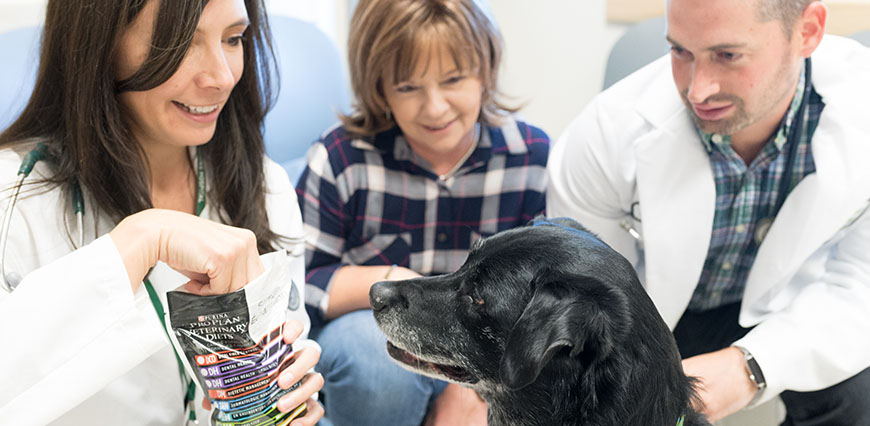
Dr. Jonathan Stockman, right, and Dr. Camille Torres-Henderson, left, are the veterinarians with the newly established Clinical Nutrition Service at CSU’s James L. Voss Veterinary Teaching Hospital. (Photo by William A. Cotton/CSU Photography)
By Dr. Jonathan Stockman
Whether your pet is perfectly healthy, overweight, or ill, diet plays an important role in helping animals feel their best.
It’s always best to consult with your veterinarian for reliable advice on what to feed your pet – in part because many owners are concerned about the ingredients used in pet food manufacturing, yet much of the information available online is inaccurate and misleading.
Below are some common questions we hear in the Clinical Nutrition Service at the James L. Voss Veterinary Teaching Hospital. Read about the newly established service.
I prefer to cook food for my dog rather than giving him store-bought dog food. Is this safe?
Many owners prefer to provide their pets with home-cooked diets rather than using commercial products. While home-cooked diets may provide a healthful substitute for commercial diets, it is important to ensure the food provided is complete and balanced so no nutritional deficiencies arise over time.
- Many recipes available online, in books, and in magazines do not provide a complete and balanced diet. Have the recipes you plan to use evaluated by a veterinary nutritionist to ensure nutritional adequacy.
- Avoid ingredients that may be toxic for dogs and cats, such as onion, garlic, grapes, raisins, chocolate, and macadamia nuts.
I am trying to help my pet lose weight, but so far have had no success. What am I doing wrong?
Pet obesity is an epidemic. Recent surveys estimate up to two-thirds of pet dogs in the United States, Europe and China are overweight or obese. While some cases of obesity may be linked to specific medical conditions, such as hormonal diseases, in most instances, excess calorie intake causes the weight gain and excess fat mass.
Overweight and obese conditions long have been recognized as risk factors for secondary health problems, such as urinary tract infection, diabetes (in some species), and even cancer. Excess energy intake – eating more calories than are burned per day – is associated with a shorter life span in dogs, as well as other species. Obesity may also exacerbate existing conditions, such as orthopedic disease, heart disease, and respiratory disease.
- Calorie restriction is the key for weight loss. While increased physical activity may help with weight loss and with maintaining muscle mass, it cannot replace dietary management.
- A prescription weight-loss diet is the preferred approach in the management of weight loss. Prescription diets are formulated to provide all the needed nutrients as overall intake is restricted. This approach ensures that nutritional deficiencies are avoided.
- Prescription weight loss diets also include strategies to address satiety and begging behaviors in pets.
- Recent evidence suggests that high-moisture diets may promote increased activity and potentially promote weight loss.
- Regular monitoring of body weight and body condition by a veterinarian is vital to adjust caloric intake and ensure a healthy and steady weight-loss rate.
How do I know if the diet I buy in the store is of good quality? What should I look for?

It is difficult to judge pet food’s quality by looking at the label. Also “quality” may mean different things to different people and for different pets. For example, many people think that a high protein, highly digestible diet is of better quality, when in fact, excess protein may not be beneficial, and at times, high-fiber foods are more suited for only some dogs and cats.
Commercial pet food is regulated by the Food and Drug Administration, which requires that “all animal foods, like human foods, be safe to eat, produced under sanitary conditions, contain no harmful substances, and be truthfully labeled.”
Some ingredients have been propagated as unhealthful and “cheap,” while in reality these ingredients provide important nutrients (Internal organs are an example).
- While specific dogs and cats may be sensitive to certain ingredients, such as corn, grains, or wheat, these are not inherently harmful. They provide fiber, vitamins, and energy in the diet.
- Verify that the pet food label has an adequate Association of American Feed Control Officials. This claim may be stated in several ways:
- “This food has been formulated to meet the nutritional levels established by the AAFCO dog/cat Food Nutrient Profiles for the specific life stage.” (This means that the diet has been formulated by a computer to meet the nutritional requirement for cats/dogs at a specific life stage, but has not undergone trials in live animals.)
- “Animal Feeding Tests substantiated that the food provides complete and balanced nutrition for the species and the life stage.” (This means that this diet has been tested in animals under the AAFCO feeding protocols and has been approved according to the specified criteria.)
- The World Small Animal Veterinary Association offers a comprehensive nutrition toolkit for veterinarians and pet owners.
My dog has been diagnosed with kidney disease, but refuses to eat any of the prescription renal diets I tried after a few days. Can I just feed him a regular diet?
Kidney disease is a very common illness in aging dogs and cats. It is estimated that up to half of cats over 15 years of age have chronic kidney disease, which makes nutrition even more important for them.
- Prescription diets are formulated to address the metabolic changes that result from kidney disease.
- Use of prescription renal diets in cats with chronic kidney disease has been shown to increase longevity and decrease the severity of clinical signs associated with the disease in these patients.
- Food aversion is common in dogs and cats with advanced stages of kidney disease. Some patients may respond well to a rotation of several prescription diets.
- A home-prepared diet may be formulated by a veterinary nutritionist to help with the management of these cases and to allow a targeted approach to address the needs of the specific patient.
Read about the newly established service at the James L. Voss Veterinary Teaching Hospital.
Dr. Jonathan Stockman is a board-certified veterinary nutritionist who joined the CSU the James L. Voss Veterinary Teaching Hospital in 2016 after three years as a senior researcher in the Waltham Centre for Pet Nutrition in the United Kingdom.